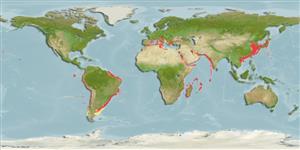Common names from other countries
Environment: milieu / climate zone / depth range / distribution range
Écologie
; profondeur 0 - 320 m (Ref. 865). Temperate
Circumglobal in tropical and temperate seas.
Length at first maturity / Taille / Poids / Âge
Maturity: Lm ? range ? - ? cm Max length : 10.0 cm H mâle / non sexé; (Ref. 3248)
Maximum depth from Ref. 116066. Epibenthic, encrusting, erect (Ref. 116066). Found in rocky subtidal (Ref. 116251), on giant kelp fronds, pilings, and boats hulls to a depth of 80 meters (Ref. 865). Suspension feeder (Ref. 116251). Part of fouling communities attached to raft frames in mariculture zones (Ref. 127121).
Life cycle and mating behavior
Maturité | Reproduction | Frai | Œufs | Fécondité | Larves
Members of the phylum Bryozoa are hermaphroditic. Both fertilization and egg brooding may either be internal or external.
Gappa, J.L. 2000. (Ref. 1202)
Statut dans la liste rouge de l'IUCN (Ref. 130435)
statut CITES (Ref. 108899)
Not Evaluated
Not Evaluated
Utilisations par l'homme
| FishSource |
Outils
Plus d'informations
Taille/Âge
Croissance
Longueur-poids
Longueur-longueur
Morphologie
Larves
Abondance
Sources Internet
Estimates based on models
Preferred temperature
(Ref.
115969): 14.8 - 24.9, mean 19.7 (based on 400 cells).
Vulnérabilité
Low vulnerability (10 of 100).
Catégorie de prix
Unknown.
